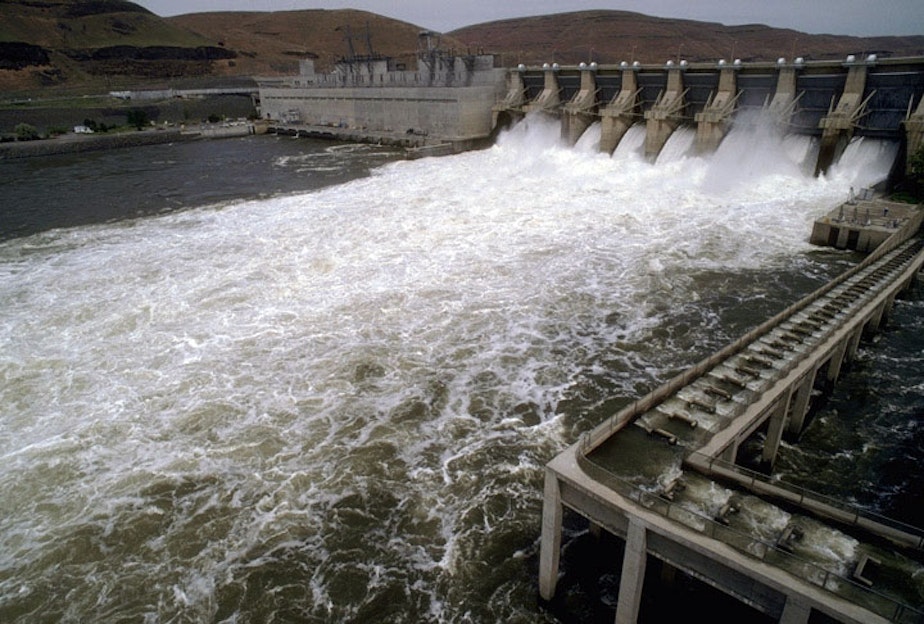Meetings On Future Of Snake River Dams Now Teleconferences: How To Access

The federal government kicked off teleconference meetings Tuesday on its draft plan to manage the Columbia and Snake River dams. In-person meetings were switched to teleconferences to protect public health during the coronavirus outbreak.
Normally, public meetings involving the fate of the Snake River dams draw standing-room-only crowds. Far fewer people spoke on the teleconference Tuesday.
Conservation groups have been worried about participation. They already pushed for a longer comment period, before the in-person meetings were canceled.
“It was, in our minds, inadequate to start with, with a very short 45-day comment period for the purposes of receiving comments from the public on a document that exceeds 8,000 pages,” said Joseph Bogaard, with the group Save Our Wild Salmon. “This inadequacy and insufficiency on the part of the public comment process has been greatly exacerbated by the public health crisis caused by the coronavirus.”
The Tuesday meeting was at times halting, as the line went silent while people waited for other commenters to join the call. Many comment-less moments stretched for more than 30 minutes, with a comment or two interspersed between the silence periods.
Sponsored
“Currently we have no other callers cued to provide comments. We’ll pause for a minute,” teleconference facilitator Miriam Habibi said multiple times during the four-hour call.
A total of 33 people provided comments during the first teleconference. Each person had three minutes to speak, although most didn’t use the entire allotted time.
Federal managers will host six total teleconferences. The remaining ones take place:
–Days: March 18, 19, 25, 26, 31
–Times: 4 p.m. to 8 p.m. PT
Sponsored
–Toll-free: 844-721-7241
–International: 409-207-6955
–Access Code: 5998146#
People can also submit comments online through April 13, 2020.
On the conference call, a few people supported more study and alternatives other than the plan the government has proposed. Slightly less than half of the people said they prefer the alternative, which keeps the dams in place.
Sponsored
The federal government’s draft environmental impact statement does not support the controversial option of removing or altering the four Lower Snake River dams. It does propose spilling more water over the dams to help juvenile salmon migrate out to sea faster.
Will Godfrey, a Lewiston resident, said fish need more help.
“To me, the (biological plan) is meaningless. It’s kind of like doing the same thing over and over. We’ve been doing it now six times, maybe. If you do the same thing over and over and expect a different result, you must be nuts,” Godfrey said.
Many conservation and fishing groups say increased spill is only a stop-gap measure for threatened and endangered salmon and steelhead.
We need positive change. We don’t need a band-aid. This is an open wound,” said Toby Wyatt, a fishing guide in Clarkston, Washington.
Sponsored
Federal judge Michael Simon previously ordered dam managers to take a serious look at all alternatives to protecting threatened and endangered salmon, which included the fate of the Snake River dams.
Speaking as a private citizen, Clarkston resident Wanda Keefer said she supported the preferred alternative.
“I do not think it was appropriate for judge Micheal Simon to mandate Snake dam removal as an alternative. The three federal agencies are being forced to address a much larger problem, when their mandate is to accomplish multiple objectives on a single river system,” Keefer said.
Several callers said removing the dams could create undue economic harm in the region.
Brian Shinn, an Asotin County commissioner, quoted a former director of the Washington Department of Ecology, saying, “Remember the whole notion of ecology includes man,” Shinn said. “I can assure you the (preferred alternative) will work. Removing the dams will not restore the salmon runs.”
Sponsored
During this teleconference Tuesday, several Idaho outfitters raised concerns that they didn’t feel like the draft plan paid much attention to their economic concerns, as fewer fish return to areas where they guide tours.
“Idaho’s outfitters, guides and rural fishing communities were literally and completely ignored from impact analysis, despite readily available information,” said Aaron Lieberman, the executive director of Idaho Outfitters & Guides Association.
Some outfitters noted their group only received a qualitative analysis, while other groups, like barging and agricultural groups, received a quantitative analysis in the draft report.
About half of the people who commented advocated for a variety of options for the operations of the Columbia and Snake River dams – many of those commenters supported removing the dams.
Former Nez Perce tribal general council chairman Gary Dorr said Northwest tribes need salmon for subsistence food, which he said tribal members need during the current coronavirus outbreak.
“The Nez Perce tribe has a greater stake in this than anyone else who is speaking here on the line today,” Dorr said. “You, as a nation, need to stick to your word and remove that impediment to our way of life.”
Other Nez Perce tribal members on the call echoed those concerns.
Dorr later requested that the agencies’ lines remain open so that those listening could hear what they had to say. The meeting facilitator said no agency officials were speaking during the silent stretches of the call, no commissioners were present and that the silence was meant to provide time for the public to comment.
The federal government is expected to publish a final environmental impact statement this summer. It will post a record of decision by Sept. 30, 2020.Courtney Flatt covers environmental and natural resource issues for Northwest Public Broadcasting. She is based in Washington’s Tri-Cities. On Twitter: @courtneyflatt Copyright 2019 Northwest Public Broadcasting. To see more, visit nwpb.org [Copyright 2020 Northwest News Network]
